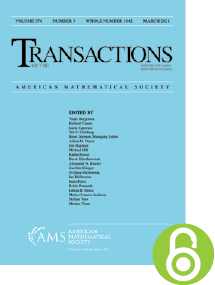Modular constructions for combinatorial geometries
HTML articles powered by AMS MathViewer
- by Tom Brylawski PDF
- Trans. Amer. Math. Soc. 203 (1975), 1-44 Request permission
Abstract:
R. Stanley, in an investigation of modular flats in geometries (Algebra Universalis 1-2 (1971), 214-217), proved that the characteristic polynomial $\chi (x)$ of a modular flat $x$ divides the characteristic polynomial $\chi (G)$ of a geometry $G$. In this paper we identify the quotient: THEOREM. If $x$ is a modular flat of $G,\chi (G)/\chi (x) = \chi (\overline {{T_x}} (G))/(\lambda - 1)$, where $\overline {{T_x}} (G)$ is the complete Brown truncation of $G$ by $x$. (The lattice of $\overline {{T_x}} (G)$ consists of all flats containing $x$ and all flats disjoint from $x$, with the induced order from $G$.) We give many characterizations of modular flats in terms of their lattice properties as well as by means of a short-circuit axiom and a modular version of the MacLane-Steinitz exchange axiom. Modular flats are shown to have many of the useful properties of points and distributive flats (separators) in addition to being much more prevalent. The theorem relating the chromatic polynomials of two graphs and the polynomial of their vertex join across a common clique generalizes to geometries: THEOREM. Given geometries $G$ and $H$, if $x$ is a modular flat of $G$ as well as a subgeometry of $H$, then there exists a geometry $P = {P_x}(G,H)$ which is a pushout in the category of injective strong maps and such that $\chi (P) = \chi (G)\chi (H)/\chi (x)$. The closed set structure, rank function, independent sets, and lattice properties of $P$ are characterized. After proving a modular extension theorem we give applications of our results to Crapo’s single element extension theorem, Crapo’s join operation, chain groups, unimodular geometries, transversal geometries, and graphs.References
- Garrett Birkhoff, Lattice theory, 3rd ed., American Mathematical Society Colloquium Publications, Vol. XXV, American Mathematical Society, Providence, R.I., 1967. MR 0227053
- George D. Birkhoff, A determinant formula for the number of ways of coloring a map, Ann. of Math. (2) 14 (1912/13), no. 1-4, 42–46. MR 1502436, DOI 10.2307/1967597
- G. D. Birkhoff and D. C. Lewis, Chromatic polynomials, Trans. Amer. Math. Soc. 60 (1946), 355–451. MR 18401, DOI 10.1090/S0002-9947-1946-0018401-4 R. Bixby, Composition and decomposition of matroids and related topics, Thesis, Cornell University, Ithaca, N. Y., 1972.
- Terrence Brown, Deriving closure relations with exchange property, Möbius algebras (Proc. Conf., Univ. Waterloo, Waterloo, Ont., 1971) Univ. Waterloo, Waterloo, Ont., 1971, pp. 51–55. Notes (and an editorial appendix) by H. Crapo and G. Roulet. MR 0357161
- Thomas H. Brylawski, A combinatorial model for series-parallel networks, Trans. Amer. Math. Soc. 154 (1971), 1–22. MR 288039, DOI 10.1090/S0002-9947-1971-0288039-7
- Thomas H. Brylawski, A decomposition for combinatorial geometries, Trans. Amer. Math. Soc. 171 (1972), 235–282. MR 309764, DOI 10.1090/S0002-9947-1972-0309764-6
- Thomas H. Brylawski, The Möbius function on geometric lattices as a decomposition invariant, Möbius algebras (Proc. Conf., Univ. Waterloo, Waterloo, Ont., 1971) Univ. Waterloo, Waterloo, Ont., 1971, pp. 143–148. MR 0379245 —, An outline for the study of combinatorial pregeometries, Notes, University of North Carolina, Raleigh, N. C., 1972. —, An affine representation for transversal geometries, Studies in Applied Mathematics (to appear). T. Brylawski and D. Lucas, Uniquely representable combinatorial geometries, Proc. Internat. Colloq. on Combinatorial Theory, Rome, Italy, 1973.
- Henry H. Crapo, A higher invariant for matroids, J. Combinatorial Theory 2 (1967), 406–417. MR 215744, DOI 10.1016/S0021-9800(67)80051-6
- Henry H. Crapo, The joining of exchange geometries, J. Math. Mech. 17 (1967/1968), 837–852. MR 0241317
- H. H. Crapo, Chromatic polynomials for a join of graphs, Combinatorial theory and its applications, I (Proc. Colloq., Balatonfüred, 1969) North-Holland, Amsterdam, 1970, pp. 239–245. MR 0299524 —, Constructions in combinatorial geometries, Notes, Bowdoin College, Brunswick, Me., 1971.
- Henry H. Crapo and Gian-Carlo Rota, On the foundations of combinatorial theory: Combinatorial geometries, Preliminary edition, The M.I.T. Press, Cambridge, Mass.-London, 1970. MR 0290980
- William Graves, An algebra associated to a combinatorial geometry, Bull. Amer. Math. Soc. 77 (1971), 757–761. MR 286688, DOI 10.1090/S0002-9904-1971-12797-0
- Curtis Greene, A rank inequality for finite geometric lattices, J. Combinatorial Theory 9 (1970), 357–364. MR 266824, DOI 10.1016/S0021-9800(70)80090-4
- Curtis Greene, On the Möbius algebra of a partially ordered set, Möbius algebras (Proc. Conf., Univ. Waterloo, Waterloo, Ont., 1971) Univ. Waterloo, Waterloo, Ont., 1971, pp. 3–38. With two appendices by Henry Crapo and a reprint of an article by Louis Solomon. MR 0349501
- Gian-Carlo Rota, On the foundations of combinatorial theory. I. Theory of Möbius functions, Z. Wahrscheinlichkeitstheorie und Verw. Gebiete 2 (1964), 340–368 (1964). MR 174487, DOI 10.1007/BF00531932 J. Sonner, The language of arrows (to appear).
- Richard P. Stanley, Modular elements of geometric lattices, Algebra Universalis 1 (1971/72), 214–217. MR 295976, DOI 10.1007/BF02944981
- Richard P. Stanley, Supersolvable semimodular lattices, Möbius algebras (Proc. Conf., Univ. Waterloo, Waterloo, Ont., 1971) Univ. Waterloo, Waterloo, Ont., 1971, pp. 80–142. MR 0354472
- W. T. Tutte, Lectures on matroids, J. Res. Nat. Bur. Standards Sect. B 69B (1965), 1–47. MR 179781, DOI 10.6028/jres.069B.001
- Hassler Whitney, 2-Isomorphic Graphs, Amer. J. Math. 55 (1933), no. 1-4, 245–254. MR 1506961, DOI 10.2307/2371127
- L. R. Wilcox, Modularity in the theory of lattices, Ann. of Math. (2) 40 (1939), no. 2, 490–505. MR 1503473, DOI 10.2307/1968934
- Thomas A. Dowling and Richard M. Wilson, Whitney number inequalities for geometric lattices, Proc. Amer. Math. Soc. 47 (1975), 504–512. MR 354422, DOI 10.1090/S0002-9939-1975-0354422-3
Additional Information
- © Copyright 1975 American Mathematical Society
- Journal: Trans. Amer. Math. Soc. 203 (1975), 1-44
- MSC: Primary 05B35
- DOI: https://doi.org/10.1090/S0002-9947-1975-0357163-6
- MathSciNet review: 0357163


